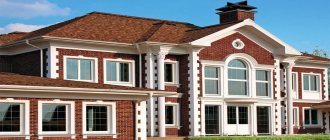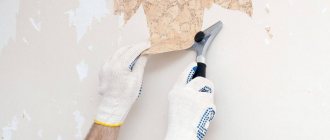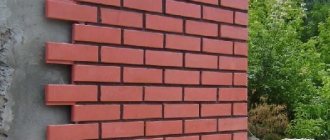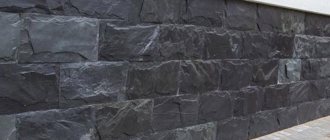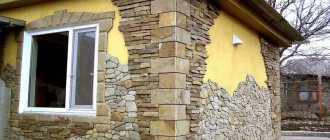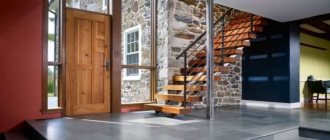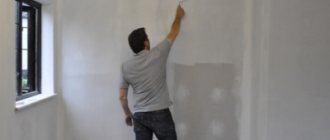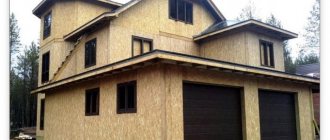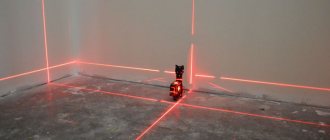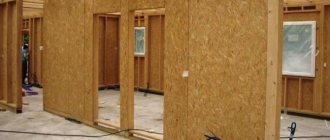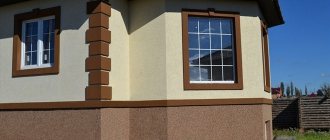Finishing walls with stone almost always ensures durability and long service life. However, processing a wall with natural or artificial stone is a rather difficult and expensive task. But there is a special decorative plaster that creates an imitation. It will allow you to achieve almost the same result, while spending significantly less money and effort. In this article we will talk in detail about decorative stone-like plaster and look at how to apply it correctly to the wall.
Pros and cons of this combination
When considering any finishing option, you always want to start with the positive aspects of a particular choice.
Regarding the combination of plaster with decorative stone, the advantages are:
- The plaster material itself provides a high level of protection for the walls of the structure. A plastered house is resistant to negative external factors, this is especially important if the building is built from aerated concrete blocks or foam concrete.
- Considering that decorative stone trim is added to the plaster, this gives the house a beautiful and sophisticated design . With this combination it is possible to implement an individual design solution.
- This type of finishing can be done on almost any house that is built in a classic design. Houses that adhere to the country style will look good.
Example of façade finishing
The nuance, insignificant at first glance, regarding the possibility of finishing the house with plaster and decorative stone, is a disadvantage of this combination of materials.
Although, for the most part, there is not much difference whether to use decorative stone for finishing the facade or not.
It all comes down to the possibility of plastering the facade:
- Plaster is not suitable for houses made of wood . Accordingly, due to the impossibility of making a high-quality plaster coating on a wooden house, this becomes an obstacle to the further use of decorative stone.
- If there is an adamant desire to decorate a wooden house in this particular way, then considerable effort must be made to achieve this. Large-scale preparatory work is required.
- Accordingly, the next disadvantage of this method is the high material costs.
Otherwise, using a combination of plaster and stone for decoration is a fairly simple and reliable way to provide your home with protection and an attractive appearance.
Decorating a private house
Exterior wall design options
Complete finishing of external walls with stone is a labor-intensive and financially expensive process. In addition, stone cladding creates additional load on the supporting structure.
The most common options:
- Facing the porch and basement.
- Highlighting the basement and corners of a private house.
- Design of window and door openings.
- The fragmentary decoration of individual sections of the facade looks incredibly beautiful.
- The technique of using different types of rocks is unique.
- Various stone compositions look impressive.
The imagination of the owners and the advice of specialists can become the source of an individual picture in the design of external walls. The main thing is to take into account the characteristics of the material and follow the masonry technology.
Selection of plaster
First of all, when faced with finishing work that will combine plaster and stone, you need to choose the right material.
This process is quite simple, since initially there are different types of plaster.
Their classification is based on the base material.
Depending on this, it is divided into types that are used for:
- Foam plastic. Such plaster is often used as insulation. One of its disadvantages is its fragility. In case of a small impact, there is a risk of spider-like cracks appearing.
- Brick. A mandatory characteristic should be increased lightness of the material. This is necessary so that after plastering the house does not receive excess load.
- Aerated concrete. An important characteristic of such a material should be increased performance properties. Accordingly, the price range of this material will be slightly larger than that of others.
- Foam blocks . An important feature of plaster for this base is the property that provides free access of oxygen to the walls of the house. This is necessary so that the structure can “breathe”.
To make an error-free choice, you only need to know what material was used to build the house. Knowing this, it is very easy to purchase plaster specialized for it.
IMPORTANT!
In the selection process, it is necessary to focus on the above-described properties of the materials for each of the bases.
General perception with fundamental natural material
Methods for creating a surface that visually imitates natural stone
The visually favorable perception of stone is based on the association with a fundamental natural material that has been used for centuries to strengthen buildings. The appearance of a stone, from an aesthetic point of view, evokes a feeling of calm and tranquility in people. At the same time, decorating premises with natural stone is not always possible due to high cost, complex installation, and technical characteristics of the surface (weak structures). In this case, “substitutes” for natural stone are available on the market - decorative plaster to look like stone and artificial decorative stone. Let's take a closer look at the materials.
There are modern methods of creating a surface that imitates natural stone, and each of these methods has both advantages and disadvantages.
One of the technologies for obtaining the texture of natural stone on various surfaces of a living space is the use of decorative plaster. This material produces a surface very similar in both texture and color to different types of natural stone. Decorative stone-like plaster is a modern finishing option for those who need to achieve the visual effect of a stone surface.
Let's take a closer look at the composition of decorative stone-like plaster
The base consists of stone chips, which are obtained during the processing of natural stone. Very often crushed granite or marble is used. The main binding element of the composition is cement, while its plasticity is ensured by added lime. Quartz sand, mica, and various dyes are responsible for the decorative properties.
The technology for creating a surface that imitates natural stone is obtained through a special form that is applied to the plaster applied to the surface.
Types of textures
This characteristic of plaster is a decorative description of the appearance. This characteristic does not have any influence on the practical properties of the material.
There are three texture options:
- Bark beetle This texture is one of the most common. There are quite a lot of options for its execution. Standard versions are represented by vertical, horizontal, circular and cross bark beetles . It is possible to use this material to create an individual textured design yourself. The texture of this plaster is acquired using grout. Using a plastic float, grout is carried out in a certain direction. At the same time, small pebbles contained in the material are scratched in a given direction by stripes and waves, which forms a textured pattern.
- Pebble. This type of material is characterized by its versatility. With its help, it is possible to make any desired pattern and various designs from a whole palette of colors . There are countless options that such plaster can create. Textured plaster of this variety is characterized by a special surface, which is covered with fine-grained crumbs (fraction size 1-3 mm), covering the wall quite tightly.
- Mosaic . This variety is completely different from the previous two. Each purchased composition has its own version. It looks like a complete transparent surface, in which natural stone granules are interspersed with an admixture of crumbs of various minerals. The crumbs are distinguished by high-strength properties. In addition to beauty, this type of plaster is characterized by increased strength.
Types of textures
Painting and impregnation with a protective composition
Facade paints are widely used in the external decoration of cottages, reviving simple and complex architectural forms. This solution can be seen in house designs with brick, aerated concrete, and frame walls. Modern paint and varnish coatings are durable, resistant to weather factors (sun, rain, frost), and contain up to 40 different components. Their cost directly depends on this.
For example, most private houses in Europe are yellowish, gray, terracotta, brown in color - this expresses the characteristic habit of saving. Inexpensive pigments based on ferrous oxides are “champions” in light fastness. It is worth noting new high-tech compounds that have the property of repelling dirt, like lotus petals that never get wet in water.
8. Combined design of a country house in gray and brown tones
9. For painting a private building, an interesting tone of light olives was chosen, against which bright elements benefit
The shade can be anything, it is important that it matches its architecture, idea, and finally the surrounding landscape. In most cases, people choose bright and light shades, but there are examples where black looks very original and not at all intimidating.
10. Minimalist architecture is ideally emphasized with a black shade
11. Black color beautifully sets off the yellow-red shades of autumn that are present in wooden structures
12. The design successfully combines a combination of black, gray, and a little red, helping the house to blend harmoniously with the surrounding nature
Wooden buildings require protection from the elements to an even greater extent than brick ones. Traditionally, bio-moisture-proof impregnations are used for this, transparent and tinted, if you want to preserve the structure of the wood. But paints are also often used - their advantage is the huge number of possible tinting shades. For solid (plastered) surfaces, matte painting is better, and for small-elements (stone, wood) - semi-gloss.
13. The azure shade in combination with white doors and windows gives the country cottage a “fairy-tale” and elegant look
14. A private country house with half-timbered finishing looks like a watercolor picture
15. The amazing color of the crimson sunset will not allow such a structure to get lost in the surrounding landscape (painting)
Stone selection
Such a preparatory stage as the choice of decorative stone depends only on the desires and capabilities of the owner of the house.
The easiest way is to make decorative stone yourself, however, the material turns out to be very simple and does not look as rich as a ready-made one.
Depending on the result that needs to be achieved during facade finishing, materials for decoration are selected from the following options:
- Klinenkerny . The stone is made from clay material and has high environmental friendliness and frost resistance. Regarding texture variations, there are a large number of them.
- Concrete cladding . It is considered one of the most affordable options, capable of imitating a large number of rocks and textures. It has durability and high strength.
- Resin based . Natural stone chips are used for production. This type of stone is as close in appearance as possible to natural stone. Features a rich variety of textures.
- Facade . This stone is made of ceramic. In appearance it resembles small bricks and rectangles. To finish the facade, you can only use one that is attached to the surface using a cement base. Otherwise, the duration of operation will be short.
- Polymer sand . It can often be seen used as brickwork. The material is characterized by high resistance to various temperatures and water. It is the most resistant material regarding mechanical damage.
Various types of decorative stone
Application rules
Working with the facade of a building involves dependence on the weather. Otherwise the result will be spoiled. So, when plastering walls, temperatures below 5 and above 30 degrees and high humidity should be avoided.
You should not start such work immediately after rain, or if there is a risk of active exposure to sunlight.
If the appropriate conditions exist, you should adhere to the following sequence. First you need to prepare the solution and tools. When applying the coating mechanically, it is worth taking care of scaffolding, scaffolding and hanging cradles.
The first layer is a leveling compound, which is then left to dry completely. Then the surface of the walls must be puttied in order to achieve greater evenness. After the putty has hardened, you need to sand the layer.
The next step is to apply the primer. Decorative plaster is supposed to be applied on top of it. The final stage of work will be applying paint.
Technology of façade finishing with stone and plaster
Finishing work, which combines facade plaster and stone, is carried out as follows (photo of the work below):
- initially carry out preparatory work , which consists of cleaning the old coating, cleaning the seams and applying a special previous solution;
- after a couple of hours they begin to apply the plaster material and leave until completely dry;
- they begin decorating wall surfaces with stone only after the plastering work has been completed and the material has dried and become stable;
Applying plaster
NOTE!
All work on decorating a facade with stone must be carried out in warm weather , otherwise the high adhesion properties of the adhesive mixture to the surface will be lost.
- first of all, they begin to prepare the adhesive mixture , after which they apply it to the surface of the walls in a thin layer;
- after this, apply a small amount of the adhesive mixture to the stone and press it against the wall;
- In the selected position, you must carefully tap the stone using a rubber hammer.
It is also worth paying attention to such a nuance as the texture of the reverse surface of the decorative stone. If it is smooth, then it is treated with a stiff brush before gluing the elements.
IMPORTANT!
It is recommended to start the entire work process from the bottom of the building . In the process, it is best to use cardboard, which is inserted between the masonry elements.
Applying finishing stone
This allows you to adjust the size of the seam. After several days, they begin to grout the joints using a gun.
Creating decorative cracks
Creating the effect of stone cracks can be achieved by following the following recommendations:
- The secret of this effect is to use a special hair dryer. Drying the wall should be done at maximum power at a distance of 15 centimeters from the coating;
- the number and relief of cracks depends on the humidity and quality of the mixture, as well as on the thickness of the applied layer;
- After application and drying, the wall must be grouted. In this case, you first need to work with sandpaper, and only then with a spatula;
- The cracks will need to be treated with varnish to prevent dust from getting into the gaps.
The effect of stone cracks can be seen in detail in the following photo.
Features of façade design with this combination
Stone finishing gives the building a presentable and reliable appearance. Offers made from natural or artificial stone of various shapes, textures, sizes, and colors allow you to choose the best option in terms of price and quality.
Often, in combination with stone, the façade of a house is finished with colored, stone or terrazite plaster. Various techniques of applying material are used, including sgraffito, which allows you to obtain a specific pattern on the facade of the building.
Advantages of facing with stone and plaster
Facing with stone and plaster allows you to:
- hide all defects in the walls, electrical wiring, water pipes and other communications;
- reliably protect the walls of the house from destruction under the influence of mechanical and natural factors;
- maintain the microclimate inside the building;
- increase the fire safety of the building.
The materials are characterized by frost resistance and can withstand sudden temperature changes. Modern plaster compositions are resistant to mechanical damage.
Disadvantages of facing with stone and plaster
Disadvantages of using stone and plaster when decorating a building:
- Requirements for the stability of building walls. “Breathing” walls, for example, made of lumber, will require serious additional work before plastering and facing with stone. Plaster is used for finishing stone and brick walls covered with insulation.
- High cost of work. Natural stone, of course, can be replaced with a cheaper artificial analogue, but the total cost, including cladding and plastering, will not be small.
- Natural stone is a heavy material, which affects loading and unloading and installation. Suitable only for finishing houses that can withstand many kilogram structures.
Decorative plasters for stone-like coatings in Rostov-on-Don
The interior salon “Decorator” in Rostov-on-Don offers a huge selection of decorative plasters for stone finishing, from inexpensive to exclusive.
Our salon has a large selection of materials for finishing and decorative work. Our store specialists will help you choose the right materials and select the necessary components.
Professional designers of our interior salon will give you recommendations on how to decorate a home or commercial premises using a wide variety of decorative plasters, stone textured coatings, and Venetian plasters.
We can deliver selected plasters, paints and other decorative materials throughout Rostov and the Rostov region.
Types of applying decorative plaster under stone
The method of simulating masonry using decorative plaster is to create a special texture of the coating, its colors, and extruding the relief. Imitation of stone for interior decoration is carried out using any composition - concrete, gypsum, lime, clay plasters. Both special ready-made plaster mixtures, which have specially selected combinations of ingredients, and ordinary cheap plasters are used.
Techniques for creating plasters in the form of stone are divided according to the depth of elaboration of the pattern. Smooth plaster to create the effect of natural stone - marble, granite, polished stone slab is applied evenly, covered with a wax composition, and polished. The stone-look wall turns out perfectly smooth, glossy or semi-matte.
The pattern is obtained by mixing plaster solutions of different shades or painting the surface. The wall covering with the effect of a large solid stone has a rough surface similar to stone. Imitating stone with your own hands when working with decorative plaster using this technique is the most accessible, since the work is simple and the effect is easily achieved.
Decorative plaster with a stone texture can be designed like stonework. In this case, the development of seams may not be very deep, indicated by a small groove.
It is more difficult to create such a stone-like covering with your own hands, since it is important to be able to depict believable masonry. Imitating stone on a wall in the form of three-dimensional masonry, 3D plaster requires the application of significant volumes of mortar and layer-by-layer painting.
It is easier to make three-dimensional plaster under the stone with your own hands using molds that allow you to obtain a believable drawing in the absence of artistic abilities.
Advantages of the material
When carrying out finishing work, preference is given to plaster due to a number of features:
- it is universal, suitable for treating surfaces of any type;
- This coating is distinguished by strength and reliability;
- plaster provides sufficient protection of the walls from precipitation and changes in temperature;
- Construction stores are ready to offer a wide range of materials, differing in color and texture.
The high technical qualities and external characteristics of the coating are confirmed by the photo of the facade finishing with plaster.
